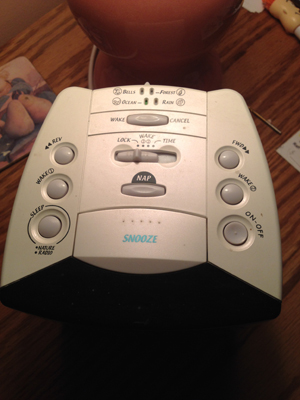(~4 minutes to read)

Here in North America, this weekend was “fall back” time for the clocks. Everyone does the dance of joy because there’s an opportunity for an extra hour’s sleep… and then stays up extra late because they can sleep in. But what should we do with that hour that we’re borrowing from spring? Sleep? Work? Relax?
Do we even really have that hour to toy with?
In our house, we have at least twenty devices that keep track of time. Fortunately, half of them look after themselves (computers, laptops, tablet, phones), but that still leaves at least ten that need attention.
And most of them work differently.
Some of them are not intuitive.
And the memory (mine, not the devices’) can’t be guaranteed to recall how to do them because like doing taxes and having one’s prostate checked, clocks only get put back once a year. (Although in the case of the prostate, participation is passive—roll on side, draw knees up, think of the empire…) So “putting the clocks back” becomes a time-stealer.
Take the microwave, for example. Ours has a “Timer/Clock” button. Press it and the screen goes blank. Press it again and there’s a colon in the middle, its blinking putting me in mind of a dog sitting in front of me, tail gently wagging, but unable to tell me what it’s waiting for. What next—find the manual? Look it up online? Either works, because who would’ve guessed that the colon was inviting me to enter a time?
One of our alarm clocks is of the “relaxing sounds” kind; it can wake you up with ocean waves or rainfall (designed, no doubt, to draw one’s attention to one’s full bladder) and has an array of sliders and buttons that would bewilder the average jumbo jet pilot. Because it looked so complex, I studied the manual in detail soon after we got the clock, and I remember that I have to slide the “Lock” button to the “Time” position and then use the “rev” and “fwd” buttons to set the time. Oh… and then I have to move the slider back to “Lock”. Intuitive it’s not, but for some reason it is memorable.
That’s five or ten minutes spent on just two clocks, and that hour I’m borrowing from spring is now down to fifty minutes.
Now we move onto my wrist watch. It’s a Timex Indiglo (yeah—I’m a classy guy!) and it’s “a few years old” now. The labelling for the four buttons is long-gone and I have no clue what each one does anymore. On top of that, the buttons themselves are like my muscles and joints—stiff—and I never know if I pressed a button hard enough or just pressed the wrong one. Good job I kept the user guide; if only I could remember where I keep it. This is going to be a fifteen-minute search and reset operation, for sure.
Meanwhile, in the car, the clock’s still set to daylight savings time. I only remember that fact when I’m driving, and although it’s not specifically mentioned in the appropriate legislation, I’m pretty sure that setting your clock back one hour (or in the case of my car, forward eleven hours) would be considered distracted driving, so I’m going to have take a special trip out to the garage to do the deed. Thing is, like most people, we keep all kinds of other stuff in the garage, and in order to make the most of the trip Itake some tin cans and cardboard boxes with me, put them in the recycle box… and forget I’d gone out there to change the clock in the car. This happens two or three times before out of frustration I dedicate a garage trip to clock-changing only.
Now multiply that by two—we have two cars with clocks… (You don’t think I’m smart enough to remember to change both cars’ clocks in one trip, do you?)
But wait; we’re not done yet. Our heating’s coming on and going off an hour later than it should. Aaaaaghh! One button changes the time and the heating schedule; let’s hope it’s clear which mode it’s in!
There’s still five more devices to go, and by now I’ve used up nearly forty minutes of that borrowed hour. If you look upon it as “interest” on the borrowed time, that kind of interest rate would make even a loan shark blush.
Fortunately, two of the remaining clocks are old-school, analogue devices. They might not keep perfect time, but they don’t take forever to adjust. Plus, because they don’t keep perfect time, we get more practice adjusting them.
Okay, so if you add all that adjusting time together, they probably take as much time out of our lives as the “one button for twenty-three different functions” devices. But unless you rely exclusively on so-called “smart” devices for your timekeeping, you’re going to have to spend at least some time changing your clocks. And if your house is like ours, that time adds up.
The bad news is that when we spring forward, not only do we pay back that hour, we also have to go through the whole remembering and setting thing again. These once-per-year tasks are a “use it or lose it” thing for the memory, especially when your life clock is reading somewhere around 8:45pm. Now there’s a clock I wouldn’t mind putting back, and probably more than one hour.
So, I ask again…What should we do with that hour that we borrow from spring? Sleep? Work? Relax? Spend most of it changing our clocks?
I slept.
I wonder if Cher would offer a “turn back time” service each fall?

Or just leave the clocks an hour off for half the year!!! 🤣
That’s got my vote, Karla!
Well, We could be smart and follow Saskatchewan and not do this silly time wasting exercise!!!!